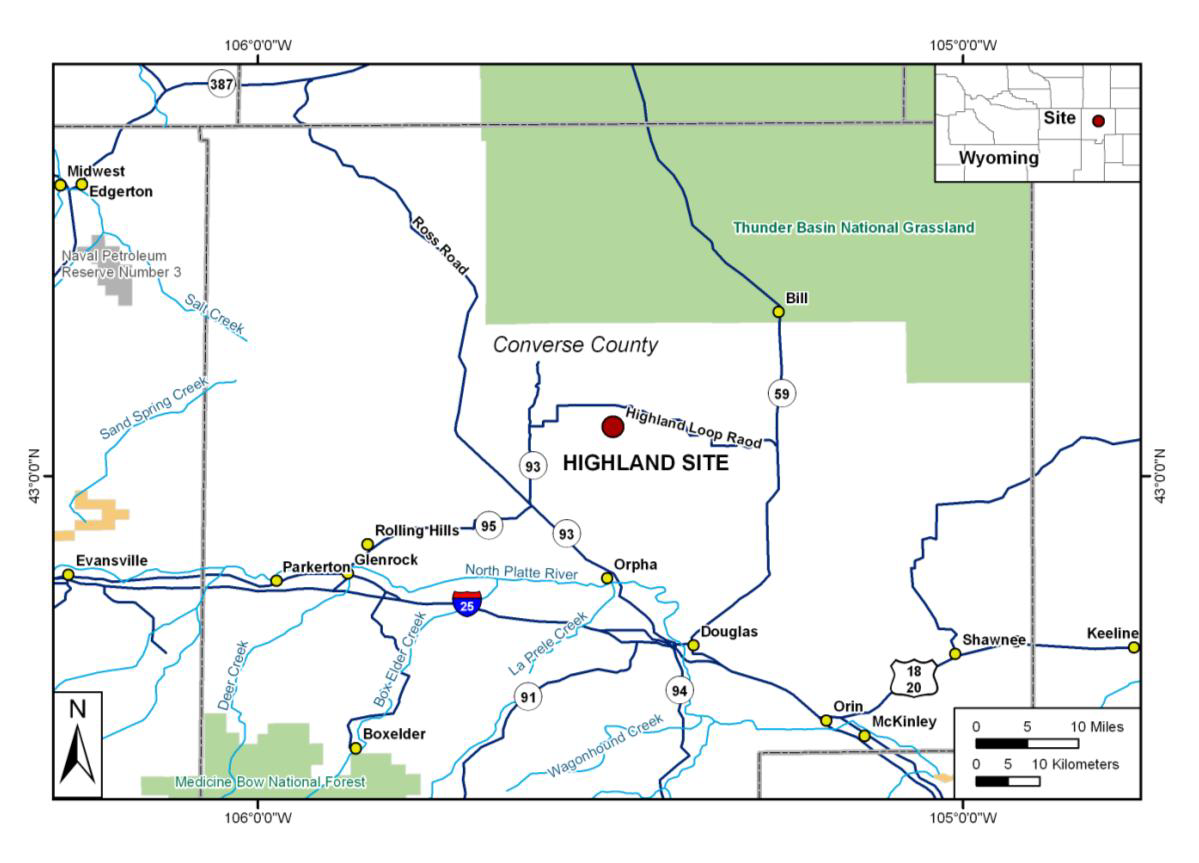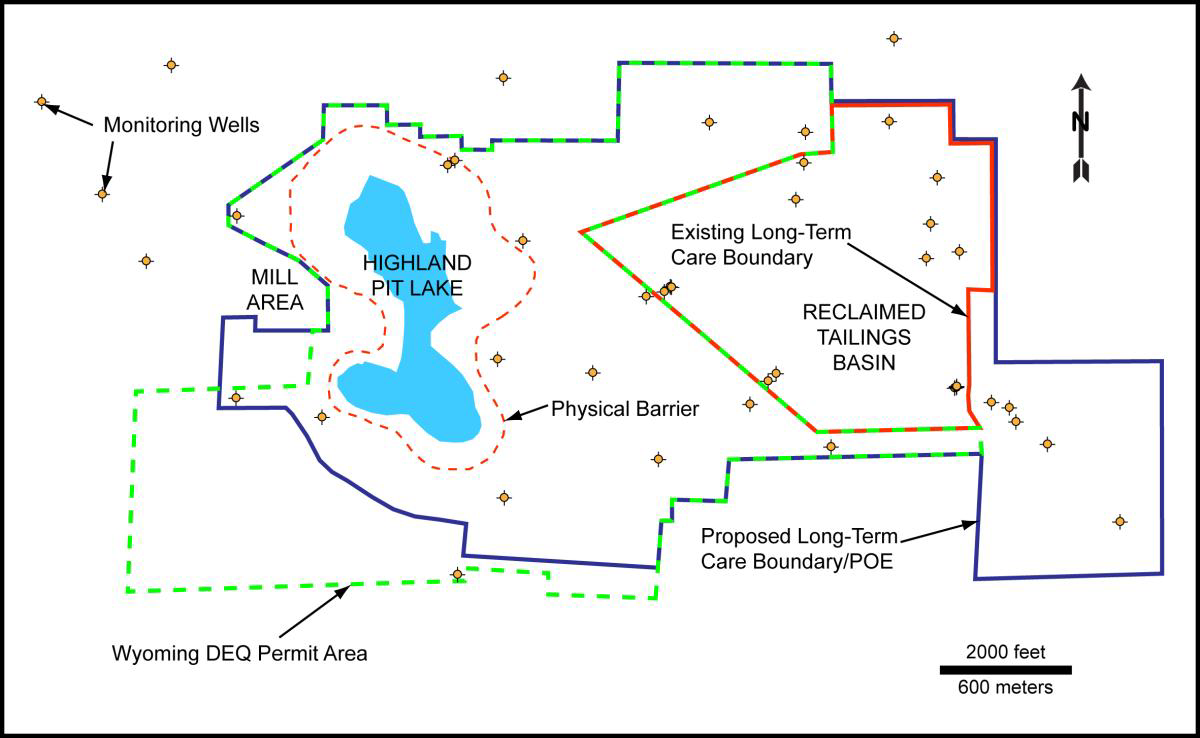ExxonMobil Highlands
1.0 General Site Information
| Site Location: | Converse County, WY | |
| Former NRC License No.: | SUA-1139 | |
| NRC Docket No.: | 40-8102 | |
| Agreement State Contact: | Brandi O’Brien | 307-777-6435 |
| NRC Agreement State Site Monitor: | Duncan White | Duncan.White@nrc.gov |
| NRC Site Monitor: | Thomas Lancaster | Thomas.Lancaster@nrc.gov |
2.0 Site Description
Exxon’s Highland uranium mill site is located in Converse County, Wyoming, about 35 miles north of Douglas, Wyoming (Figure 1).

Figure 1. Highland Uranium Mill Site Location Map

Figure 2. Highland Site Layout
Source: ARCADIS. “Groundwater Well Locations and WDEQ and NRC Boundaries Map.” Lakewood, Colorado: ARCADIS. 2008.
A Source Materials License No. SUA-1139 was originally issued to Standard Oil Company of New Jersey, operating as Humble Oil and Refining Company, by the Atomic Energy Commission (AEC). Exxon (then Standard) began conventional uranium milling at the Highland site in October 1972. Exxon owned and operated the uranium mines that provided the ore for the mill. A limited amount of toll milling also took place at the Highland facility.
The mill processed about 10.5 million tons of uranium ore, which did not have significant concentration of vanadium or molybdenum typical of some uranium ores. The mill contained a conventional dry crusher and wet rod mill to separate the individual grains in the ore. The resulting slurry was leached with sulfuric acid and sodium chlorate at a pH of between 1 and 1.5. The uranium was separated from the tailings through countercurrent decantation using a series of thickeners. Barren tailings were pumped into the basin at about 35 percent solids by weight. The uranium liquor was processed by solvent extraction to yield a rich eluate for uranium precipitation and drying. All aspects of mining and milling ceased in 1984 when reclamation activities began.
The uranium mill area, including the ore storage pads and the laboratory, has been cleaned up and the tailings buried under a radon barrier, eliminating nearly all potential for radiation exposures to workers or members of the general public from these sources. All windblown material has been reclaimed to unrestricted release standards.
Tailings Management and Disposal
Tailings deposition took place from the mill startup in October 1972 until June of 1984. The resultant tailings consisted of sand and slimes fractions, which were discharged to an approximate 20-acre tailings basin around the perimeter of the tailings basin, and causeways were built out into the tailings basin. The rock formations mined at the site are primarily in the Paleocene Fort Union Formation, which underlies the Eocene Wasatch Formation and are composed of a stacked sequence of sedimentary rocks that generally consist of interbedded sandstones and shales.
During operation, seepage from the tailings basin resulted in the development of a groundwater mound under and around the tailings basin. As the mound grew, it eventually reached an elevation that caused tailings fluid seepage to enter the alluvial deposits downstream of the dam. The center of the dam was keyed into the underlying Tailings Dam Shale (TDSH), which prevented any seepage moving under the dam. However, the wings of the dam were not keyed into the TDSH and allowed seepage to move through the wings and outside of the tailings impoundment. In 1975, a sump system was constructed to capture this seepage and pump it back to the tailings basin.
The underground and open pit mining that took place at the Highland site necessitated lowering the local water table below the working level in the mines. Groundwater at the site generally flows in an easterly direction. Studies done in 2007 by Exxon also suggest contaminants have seeped to the west into Pit Lake.
Several amendments have been made to the license to allow alternate concentration limits (ACLs) for groundwater at three of the point of compliance (POC) wells, on a well-by-well, constituent-by-constituent basis. In 2009, Exxon submitted a notice of intent to redefine the proposed long-term surveillance and monitoring boundary, including the establishment of new and revised ACLs with associated POCs and points of exposure (POEs). This proposal was not implemented because a plume of contamination was discovered. The following groundwater protection standards were implemented in 2006 for four POC wells (Nos. 125, 175, 176 and 177) and on background well No. 182: arsenic = 0.05 mg/L, cadmium = 0.01 mg/L, chromium = 0.1 mg/L, gross alpha = 15.0 pCi/L, lead = 0.05 mg/L, nickel = 0.1 mg/L, radium-226 and 228 = 5.0 pCi/L, selenium = 0.05 mg/L, thorium-230 = 0.55 pCi/L, and uranium = 0.03 mg/L. Exceptions were well 125 uranium = 0.089 mg/L, well 175 nickel = 1.8 mg/L, and radium-226 and -228 = 25 pCi/L, and well 177 uranium = 0.11 mg/L.
4.0 Current NRC actions/status
NRC currently has no actions for the site until the CRR is submitted by the State of Wyoming.
5.0 Expected Transition to DOE for LTS&M
2025 (See DOE LM Site Management Guide, June 2022)
Page Last Reviewed/Updated Friday, October 28, 2022
Page Last Reviewed/Updated Friday, October 28, 2022

